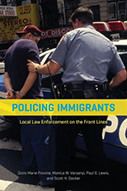POLICING IMMIGRANTS: LOCAL LAW ENFORCEMENT ON THE FRONT LINES

Authors: Doris Marie Provine, Monica W. Varsanyi, Paul G. Lewis, and Scott H. Decker
Publisher: Chicago: The University of Chicago Press, 2016. 206p.
Reviewer: Rosalyn Bocker Parks | January 2018
Policing Immigrants: Local Law Enforcement on the Front Lines examines the diverse and often inconsistent immigration enforcement in contemporary America. As the federal government calls on local communities to respond and act on evolving immigration law, the result is a “multijurisdictional patchwork” of policies and practices across communities. The first chapter of this work explores this decentralized response to immigration control and the conflicted political underpinnings at work. It also lays out the design of the research, which included the collection of survey data from 237 police chiefs and 252 sheriffs from across the nation, and seven in-depth case studies of medium sized cities.
The second chapter explores what the authors call the “evolution of devolution.” While state and local agencies played an active role in immigration control and enforcement until the late 19th century, the federal government slowly began to consolidate the power to control the entry and enforcement of immigration law. Since 1996, state and local entities, once relegated to assisting in immigration enforcement only when asked by federal agencies, have regained some of the lost local control over immigration policy. Today, local jurisdictions have enacted widely differing policies and legislation, creating the current patchwork of responses.
Chapters 3 and 4 focus on this patchwork of immigration federalism, and the influence of community context on the patchwork, respectively. While some states use the devolution of immigration control to discourage unauthorized immigrants, others integrate these individuals into their communities. The patchwork only increases in complexity in jurisdictions that have divergent views on immigration, and contextual factors such as local political leanings and the framework of state and local immigration policy play a significant role in shaping interactions between law enforcement and immigrants.
Chapter 5 examines the broad discretion used by different levels of law enforcement when policing immigrants. Differences in the use of discretion not only exist between municipalities but between individual officers in the field as well. The authors also observe that a key conflict exists between immigration enforcement and community-oriented policing, noted here as “the standard for professional policing.” In practice, community-oriented policing asserts that there needs to be trust and confidence between the police and the community they serve in order for a department to be effective. Strict adherence to immigration enforcement has a strong potential to undermine this trust.
The sixth chapter centers on a series of case studies on the experiences of four municipalities. In the communities of El Paso, TX, Allentown, PA, Dodge City, KS and Salem, OR, law enforcement officials, politicians, and community activists have negotiated understandings with the immigrant communities. These cities, like many others across the nation, have adapted federal immigration policy for their needs, resulting in different levels of enforcement and vastly differing approaches over the years.
The final chapter outlines the four main conclusions of this work. First, the authors argue that localized enforcement of immigration policy is still relatively new. Second, they posit that federal, state and local governments are guided by the needs of different constituencies, funding priorities, and mandates. Third, the multijurisdictional patchwork described here is increasing in complexity and it is improbable that this situation will soon change. Finally, the authors argue that enforcement of immigration policies has taken priority over education regarding the costs and benefits of immigration and the need to adopt constructive integration strategies in communities.
This chapter also introduces two important topics of further discussion: the limitations of this work, and the recommendations of the authors. The book offers a wealth of original research. While comprehensive in its scope, however, the book’s data sources are, by the authors’ admission, limited by several factors. One of these is the very nature of immigration enforcement. Policies and practices across jurisdictions are in a near constant state of development, and while the authors have recorded the general direction of these policies, this is an ongoing process. The authors also note that their surveys of chiefs and sheriffs across the nation relied on the inferences of these individuals to assess what their officers are doing in the field. Finally, the case studies are limited in number and were completed in a relatively short time.
With these important caveats noted, recommendations are given for future research and policy. The authors point out that research should continue to examine the role of local police in immigration enforcement during times of changing political and popular opinions. However, the authors also call for a new national commission to examine how, in an “era that rejects racism and embraces basic human rights,” to have a larger conversation on immigration in America.
Policing Immigrants is a timely, compelling book that highlights the frequently changing and often fragmented response of law enforcement to immigrants in their communities. In a time of rapidly developing politics and policy, Policing Immigrants is an important read for students of law and criminal justice, public safety managers, and, perhaps most importantly, the members of law enforcement and the communities directly impacted by this quickly evolving environment.
Rosalyn Bocker Parks, Ph.D. is a Research Project Manager at the Rutgers University Police Institute.


